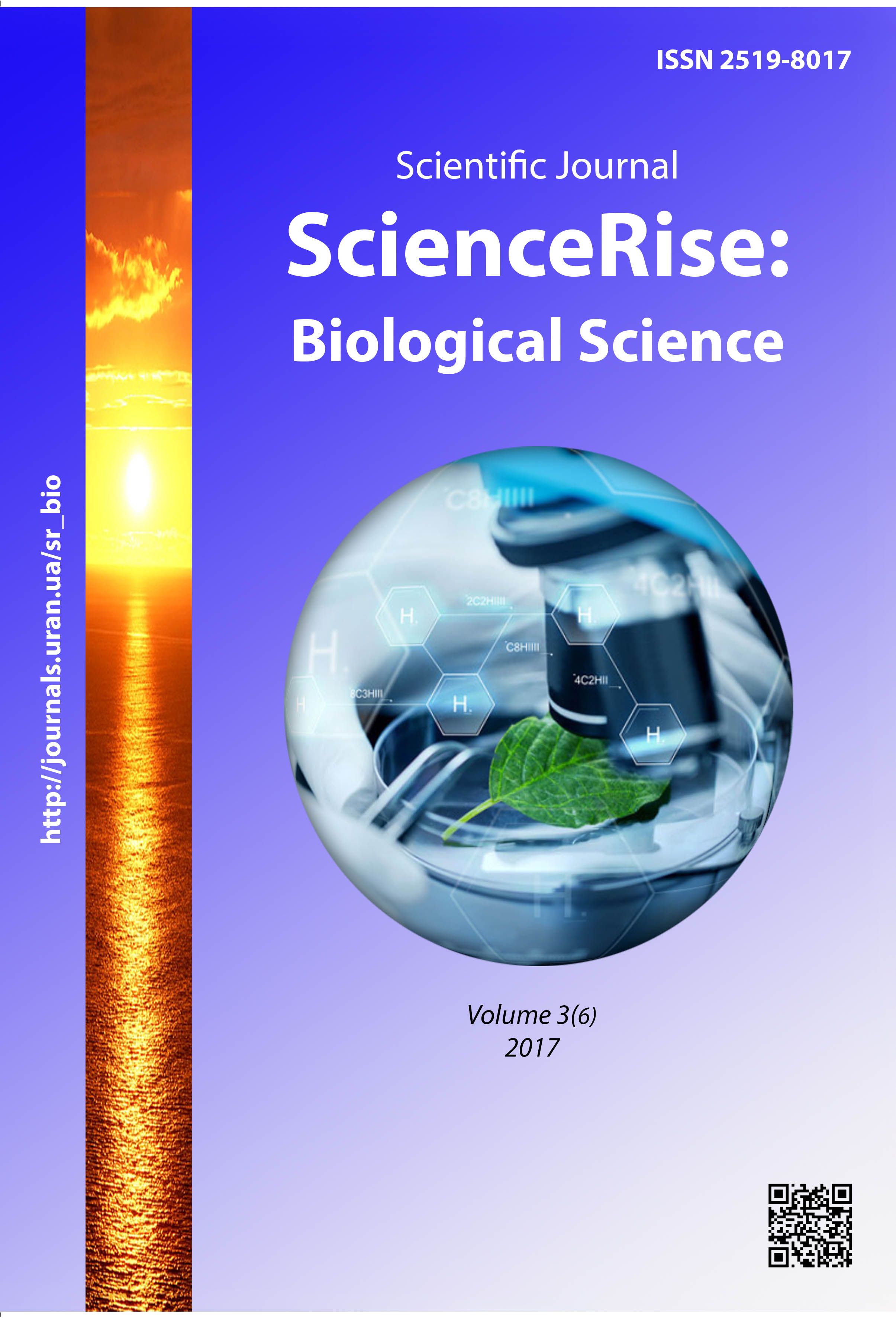Optimization of some elements of cultivation technology of ornamentals in the north-eastern part of forest-steppe of Ukraine
DOI:
https://doi.org/10.15587/2519-8025.2017.105504Keywords:
Buxus sempervirens, Thuja occidentalis, growth regulators, cutting, Rhizopon, fumar, rootingAbstract
Aim of the experiment was to study factors influencing on effectiveness of the root formation in cuttings of ornamental plants (Buxus sempervirens L., Thuja occidentalis L.).
Methods. The experiment was conducted in a nursery at the Sumy National Agrarian University, Ukraine in 2013–2015. The types and mixtures of rooting media and rooting hormones were used, and terms of plant cutting under mist were analyzed.
Results. It has been found that the best substrate for rooting cuttings of these species was a mixture of peat DOMOFLOR (pH 6.0) and sand in the ratio 1:1. It has been revealed that its acidity and the optimum time for plant cutting are important components of cultivation technology of plant propagation material. B. sempervirens is proved to be successfully propagated from April to August, and cuttings T. occidentalis – in April. There has been grounded the appropriateness of Rhizopon AA powder for rooting stem cuttings T. occidentalis.
Conclusion. The best media for rooting cuttings of ornamental species with the closed root system included peat, sand and humus in the ratio of 1:1:0.5. It set up the effect of using the rooting hormone (Rhizopon AA poeder); propagation of shrub ornamentals: B. sempervirens is more expediently from April to August by stem cuttings, T. occidentalis - in April
References
- Melnik, A. V., Tokman, V. S. (2016). Osoblyvosti rozmnozhennya Juniperus comminis L. steblovymy zhyvcyamy v umovax pivnichno-sxidnoyi chastyny Lisostepu Ukrayiny [Peculiarities of propagating Juniperus communis L by stem cuttings in the north-eastern part of forest-steppe of Ukraine]. Visnyk Sumskoho natsionalnoho ahrarnoho universytetu. Seriia: Ahronomiia i biolohiia [Herald of Sumy National Agrarian University. Series: Agronomy and Biology], 2 (31), 8–12.
- Balabak, O. A. (2012). Biolohichni osoblyvosti adventyvnoho koreneutvorennia u steblovykh zhyvtsiv dernu spravzhnoho (Cornus mas L.) [Biological properties of adventitious root formation in stem cuttings of the real turf (Cornus mas L.)]. Ahrobiolohiia [Agrobiology], 9 (96), 99–103.
- Ponomarenko, S. P. (1999). Rehuliatory rostu roslyn na osnovi N-oksydiv pokhidnykh pirydynu [Plant growth regulators on the basis of N-oxides of pyridine derivatives]. Kyiv: Tekhnika, 272.
- Hartman, H. T. et. al. (2002). Plant propagation principles and pracrices. New Jersey: Prentice Hall, 880.
- Salas, P., Saskova, H., Mokrickova, J., Litschmann, T. (2013). Evaluation of different types of rooting stimulators. Acta Universitatis Agriculturae et Silviculturae Mendelianae Brunensis, 60 (8), 217–228. doi: 10.11118/actaun201260080217
- Torchik, V. I., Kelko, A. F. (2016). Osobennosti adventivnogo korneobrazovaniya u steblevih cherenkov nekotorih sadovih form roda Juniperus v zavisimosti ot strokov zagotovki [Peculiarities of adventitious root formation οf stem cuttings of some garden forms of Genus Juniperus in dependence on harvesting time]. Trudyi Belarusskogo gosudarstvennogo tehnicheskogo universiteta [Works of Belarusian State Technological University], 1 (83), 216–219.
- Rubtsov, A. V. (2008). Deiaki aspekty vdoskonalennia pryskorenoho rozmnozhennia maloposhyrenykh ekzotiv ta vysokodekoratyvnykh kultyvariv u pivdenno-stepovomu rehioni Ukrainy [Some aspects for improvement of accelerated reproduction of not widespread exotics and highly ornamental cultivars in the southern steppe region of Ukraine]. Visnyk Dnipropetrovskoho universytetu. Biolohiia. Ekolohiia [Visnyk of Dnipropetrovsk University. Biology. Ecology], 2 (16), 141–146.
- Mauer, V. M. (2006). Dekoratyvne rozsadnytstvo z osnovamy nasinnytstva [Production of ornamental nursery crops with basics of seeding]. Kyiv: Aristey, 273.
- Makrushyn, M. M., Makrushyna, E. M., Petrosian, N. V., Melnykov, M. М.; Makrushyn, M. M. (Ed.) (2006). Fiziolohiia roslyn [Plant Physiology]. Vinnitsa: New Book, 416.
- Sokolov, T. A. (2004). Dekorativnoe rastenievodstvo. Drevovodstvo [Ornamental plant production. Arboriculture]. Moscow: ACADEMA, 345.
- Zlobin, Yu. A. (2004). Kurs fiziolohii i biokhimii roslyn [The course of Plant Physiology and Biochemistry]. Sumy: Publishing House “University Book”, 464.
- Sebanek, J. (2008). Physiology of vegetative propagation of woody species. Brno: Mendelova zemedelska a lesnicka univerzita, 60.
- Pop, T., Pamfi, D., Bellini, C. (2011). Auxin control in the formation of adventitions roots. Notulae Botanicae Horti Agrobotanici Cluj-Napoca, 39 (1), 307–316.
- Kaviani, B., Negahdar, N. (2017). Propagation, micropropagation and cryopreservation of Buxus hyrcana Pojark., an endangered ornamental shrub. South African Journal of Botany, 111, 326–335. doi: 10.1016/j.sajb.2017.04.004
- Kazakova, V. N. et. al. (1990). Metodika ispyitaniy regulyatorov rosta i razvitiya rasteniy v otkryitom i zaschischennom grunte [Methods of testing plant growth and development regulators in the open and protected soil]. Moscow: Russian State Agrarian University, 56.
- Dospekhov, B. A. (1985). Metodika polevogo opyta [Methods of field experiences]. Moscow: Agropromizdat, 351.
- Hospodarenko, H. M. (2010). Ahrokhimiia [Agrochemistry]. Kyiv: National Scientific Center “IAE”, 400.
Downloads
Published
How to Cite
Issue
Section
License
Copyright (c) 2017 Volodymyr Tokman

This work is licensed under a Creative Commons Attribution 4.0 International License.
Our journal abides by the Creative Commons CC BY copyright rights and permissions for open access journals.
Authors, who are published in this journal, agree to the following conditions:
1. The authors reserve the right to authorship of the work and pass the first publication right of this work to the journal under the terms of a Creative Commons CC BY, which allows others to freely distribute the published research with the obligatory reference to the authors of the original work and the first publication of the work in this journal.
2. The authors have the right to conclude separate supplement agreements that relate to non-exclusive work distribution in the form in which it has been published by the journal (for example, to upload the work to the online storage of the journal or publish it as part of a monograph), provided that the reference to the first publication of the work in this journal is included.









